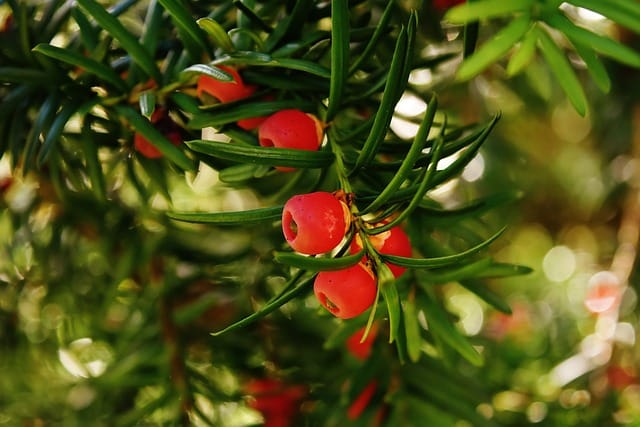Identifying Yew trees
The Yew tree is a fascinating and unique species with a long history of cultural and ecological significance

In this article:
- Introduction
- Overview of the Yew tree
- Physical description of the Yew tree
- Geographic distribution of the Yew tree
- Importance of the Yew tree
- Identifying characteristics of the Yew tree
- Potential look-alike species
- Common misconceptions about identifying the Yew tree
- Tips for accurate identification
- Conclusion
Introduction
The Yew tree is a fascinating and unique species with a long history of cultural and ecological significance. It is important to be able to accurately identify this tree in order to appreciate its beauty and understand its role in the environment.
Overview of the Yew tree
The Yew tree, scientifically known as Taxus baccata, is a coniferous evergreen tree native to Europe, North Africa, and parts of Asia. It belongs to the Taxaceae family and is one of the oldest tree species in the world, with a lifespan exceeding 1,000 years.
Physical description of the Yew tree
The Yew tree has a unique appearance compared to other conifers. It typically has a dense, conical or columnar crown with a dark, reddish-brown bark that is often flaky or peeling.
Geographic distribution of the Yew tree
The Yew tree is widely distributed throughout Europe, including the British Isles, as well as parts of Asia and North Africa. It can be found in a variety of habitats, such as woodlands, hedgerows, and rocky slopes.
Importance of the Yew tree
The Yew tree has significant ecological importance as it provides shelter and food for various animal species. It also has cultural and historical significance, being associated with ancient rituals and beliefs in many cultures.
Identifying characteristics of the Yew tree
. Needles and leaves
The Yew tree has dark green, needle-like leaves that are arranged spirally on the twigs. The leaves are flat, narrow, and about 1-3 centimeters long. They have a glossy appearance and produce a distinctive smell when crushed.
. Bark and trunk
The bark of the Yew tree is thin, smooth, and reddish-brown in color. It may peel or flake off in patches as the tree ages. The trunk is often twisted or contorted, giving the tree a unique and distinctive appearance.
. Reproductive structures
The Yew tree has separate male and female reproduction structures, which are small and inconspicuous. The male structures are called pollen cones and are yellow in color. The female structures, known as seeds or arils, are red and berry-like in appearance.
. Growth habit and size
The Yew tree has a slow growth rate and can reach a height of 15-20 meters. It has a dense, symmetrical crown and its branches tend to droop towards the ground as the tree matures.
Potential look-alike species
While the Yew tree is quite distinctive, there are a few species that may resemble it from a distance. Some examples include the Western Redcedar (Thuja plicata) and the Japanese Yew (Taxus cuspidata). Careful observation of the distinguishing characteristics can help differentiate these trees.
Common misconceptions about identifying the Yew tree
There are several misconceptions about identifying the Yew tree, such as assuming it is a deciduous tree or confusing it with other coniferous trees due to its unique characteristics. Understanding these misconceptions can help ensure accurate identification.
Tips for accurate identification
When identifying the Yew tree, consider the following tips:
- Observe the unique appearance of the Yew tree, including its bark, leaves, and growth habit.
- Pay attention to the presence of male and female reproductive structures.
- Compare the tree to potential look-alike species to ensure accurate identification.
- Consult a field guide or seek expert advice if you are unsure.
Conclusion
Identifying the Yew tree is a rewarding experience that enables us to appreciate its beauty and understand its importance in the environment. By familiarizing yourself with its distinguishing characteristics and avoiding common misconceptions, you can confidently identify this remarkable tree species.
